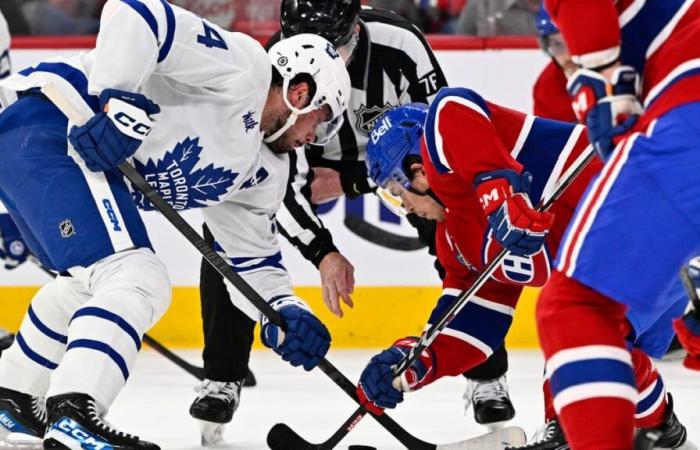Against the Islanders, the Canadian would have deserved a better fate. It was one of his best matches of the young season.
More combative, he offered a much tighter game defensively. Less lace, less turnovers. After two periods, he had only offered seven scoring opportunities to Patrick Roy’s men. And that includes the four minutes that the Habs spent, bottled up in their zone, in the first half of the second period.
Seven scoring chances in 40 minutes of play is a world of difference compared to what happened during the visits of the Penguins and Kings.
However, one fact remains: Martin St-Louis’ troops are incapable of competing in the faceoff circle. Before the pot, let’s send the flowers. In the moments before Cole Caufield’s first goal, Juraj Slafkovsky stood out by helping Nick Suzuki win his face-off against Kyle MacLean.
The reaction of a lit guy who responded perfectly to the analysis Suzuki made Thursday night after the game against the Kings.
“By winning the faceoff, it puts you in a more advantageous position. […] They are so essential. We can start plays and control the puck,” declared the captain.
Quick reactions
That said, the Canadiens’ center players only won 42% of duels near Cayden Primeau. A percentage which dropped to 36% shorthanded. Even Jake Evans and Christian Dvorak, whom St-Louis expressly sends during important faceoffs, have snatched some in their territory. Evans reached the threshold of respectability (50%), while Dvorak was eaten whole (29%).
“Facials are important, especially in the defensive zone,” Evans said after the loss to the Kings. You know that if the opponent wins, clearly, he will have the opportunity to execute a dangerous play.
What’s special against the Kings is that the Canadian won 13 of his 19 faceoffs in the defensive zone. Three of the six losses turned into goals.
That same evening, Martin St-Louis instead blamed the way his players had erred in the art of blocking shots.
“You’re going to lose some faceoffs, but it shouldn’t end up in the back of your net three times. We have to find a way to block the shots. I know that when things happen quickly, it’s more difficult to place yourself in the lines of fire,” he analyzed, nevertheless recognizing that there was room for improvement in this area.
Dach invisible
Which brings us to Kirby Dach. Returning to the game, after playing only one and a half games a year ago, the big center player was supposed to provide depth in attack. This is far from going as planned.
Photo Martin Chevalier
His 37.5% success rate in the faceoff circle is far from meeting the standards of a second-line center. Moreover, St-Louis has started to replace Alex Newhook. The poor fare even worse (31%).
Since the start of the campaign, Dach has a record of -8. Worst in the entire NHL. In his defense, it must be remembered that he was on the ice for two goals scored by the opponent into an empty net.
And as we know, with this statistic, you have to take some and leave some. That said, data compiled by Sportlogiq indicates that Dach’s expected goals percentage when playing at even strength is just 33%. Which places him at 321e rank among the 347 attackers who played at least 40 minutes.
If we look at the expected goals at the collective level, the CH generated 2.55 with Dach on the ice, compared to 5.21. This differential of -2.66 is rather far from -8.
However, it shows that when Dach is on the ice, not much happens. Starting sequences in possession of the puck would definitely help a little.
Shots attempted 97 55
Shots on target 46 31
Shots from the slot 19 18
Shots from the bottom of the slot 10 9
Scoring chances 42 24
Buts 7 0
Source: Sportlogiq






